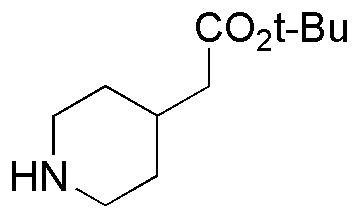Piperidin-4-yl-acetic acid tert-butyl ester is widely utilized in research focused on:
- Pharmaceutical Development: This compound serves as a key intermediate in synthesizing various pharmaceuticals, particularly those targeting neurological disorders, due to its ability to cross the blood-brain barrier.
- Agrochemical Formulations: It is used in the formulation of agrochemicals, enhancing the efficacy of pesticides and herbicides by improving their absorption in plant tissues.
- Polymer Chemistry: The compound acts as a building block in the production of specialty polymers, contributing to materials with enhanced durability and flexibility.
- Biochemical Research: Researchers utilize it in studies involving enzyme inhibition and receptor binding, aiding in the understanding of biochemical pathways and drug interactions.
- Cosmetic Industry: Its properties make it suitable for use in cosmetic formulations, providing moisturizing effects and improving skin texture.
General Information
Properties
Safety and Regulations
Applications
Piperidin-4-yl-acetic acid tert-butyl ester is widely utilized in research focused on:
- Pharmaceutical Development: This compound serves as a key intermediate in synthesizing various pharmaceuticals, particularly those targeting neurological disorders, due to its ability to cross the blood-brain barrier.
- Agrochemical Formulations: It is used in the formulation of agrochemicals, enhancing the efficacy of pesticides and herbicides by improving their absorption in plant tissues.
- Polymer Chemistry: The compound acts as a building block in the production of specialty polymers, contributing to materials with enhanced durability and flexibility.
- Biochemical Research: Researchers utilize it in studies involving enzyme inhibition and receptor binding, aiding in the understanding of biochemical pathways and drug interactions.
- Cosmetic Industry: Its properties make it suitable for use in cosmetic formulations, providing moisturizing effects and improving skin texture.
Documents
Safety Data Sheets (SDS)
The SDS provides comprehensive safety information on handling, storage, and disposal of the product.
Product Specification (PS)
The PS provides a comprehensive breakdown of the product’s properties, including chemical composition, physical state, purity, and storage requirements. It also details acceptable quality ranges and the product's intended applications.
Certificates of Analysis (COA)
Search for Certificates of Analysis (COA) by entering the products Lot Number. Lot and Batch Numbers can be found on a product’s label following the words ‘Lot’ or ‘Batch’.
*Catalog Number
*Lot Number
Certificates Of Origin (COO)
This COO confirms the country where the product was manufactured, and also details the materials and components used in it and whether it is derived from natural, synthetic, or other specific sources. This certificate may be required for customs, trade, and regulatory compliance.
*Catalog Number
*Lot Number
Safety Data Sheets (SDS)
The SDS provides comprehensive safety information on handling, storage, and disposal of the product.
DownloadProduct Specification (PS)
The PS provides a comprehensive breakdown of the product’s properties, including chemical composition, physical state, purity, and storage requirements. It also details acceptable quality ranges and the product's intended applications.
DownloadCertificates of Analysis (COA)
Search for Certificates of Analysis (COA) by entering the products Lot Number. Lot and Batch Numbers can be found on a product’s label following the words ‘Lot’ or ‘Batch’.
*Catalog Number
*Lot Number
Certificates Of Origin (COO)
This COO confirms the country where the product was manufactured, and also details the materials and components used in it and whether it is derived from natural, synthetic, or other specific sources. This certificate may be required for customs, trade, and regulatory compliance.


